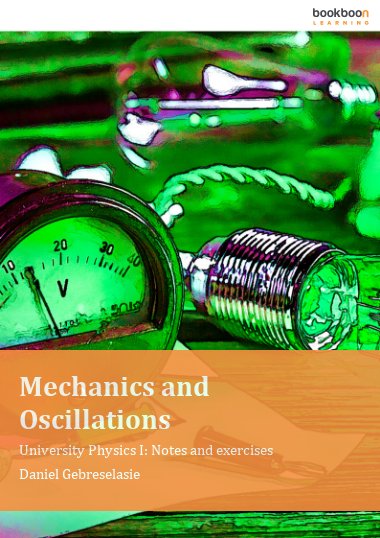This book is a calculus based treatment of mechanics. The concepts discussed include, measurement and significant figures, motion variables, vectors, forces, relationship between forces and motion, relationship between forces and circular motion, work, energy, relationship between work and energy, potential energy and conservation of mechanical energy, momentum, conservation of momentum, collisions, center of mass, rotational motion, moment of inertia, torque, relationship between torque and rotational motion about a fixed axis, physics of solids and fluids, gravitation and oscillatory motion.


Libro di testo gratuito
Mechanics and Oscillations
University Physics I: Notes and exercises
Descrizione
Contenuto
- Introduction to Mechanics
- Measurement
- Significant Figures
- Conversion of Units
- Dimensional Analysis
- Order of Magnitude Calculation
- Brief Review of Trigonometry
- Coordinate Systems
- Motion in One Dimension
- Brief Review of calculus
- Motion Variables
- Uniformly Accelerated Motion
- Motion under Gravity
- Motion Graphs
- Vectors
- Adding Vectors Graphically
- Adding Vectors Analytically
- Unit Vectors
- Dot Product
- Cross Product
- Motion in Two Dimensions
- Two Dimensional Motion Variables
- Uniformly Accelerated Motion
- Projectile Motion
- Uniform Circular Motion
- Non Uniform Circular Motion
- Relative Velocity
- Newton’s Laws of Motion
- Types of Forces
- Solving Force Problems
- Statics
- Dynamics
- Circular Motion and Applications of Newton’s Second Law
- Polar Unit Vectors
- Circular Motion in terms of Polar Coordinates
- Examples of Applications of Newton’s Second Law to Circular Motion
- Work and Energy
- Work done by a Variable Force in one Dimension
- Work done by a Variable Force in two Dimensions
- Work done by the Force due to a Spring
- Work-Kinetic Energy Theorem
- Power
- Potential Energy and Conservation of Mechanical Energy
- Conservative Force
- Gravitational Potential Energy
- Elastic Potential Energy
- Conditions of Equilibrium
- Central Forces
- Conservation of Mechanical Energy
- Work done by non-Conservative Forces
- Momentum and Collisions
- Conservation of Momentum
- One Dimensional Collision
- Completely Inelastic Collisions
- The Ballistic Pendulum
- Completely Elastic Collisions
- Two Dimensional (Glancing) Collisions
- Center of mass
- Rotation of a Rigid Object about a Fixed Axis
- Angles
- Angular Motion Variables
- Relationship between Linear and Angular Variables
- Uniformly Accelerated Angular Motion
- Moment of Inertia
- Rotational Kinetic Energy
- Moment of Inertia of Solid Objects
- The Parallel axis Theorem
- Rolling Motion
- Torque and Angular Momentum
- Net Torque
- Torque as a cross product
- Relationship between torque and Angular Acceleration for a Rotation about a Fixed Axis
- Work Done by Torque for a Rotation about a Fixed Axis
- Work-Kinetic Energy Theorem for Work done by Torque
- Angular Momentum
- Conservation of Angular Momentum
- Static Equilibrium
- Torque due to Weight
- Solids and Fluids
- Solids
- Fluid Statics
- Fluid Dynamics
- Gravitation
- Orbits due to Gravitational Force
- Kepler’s Laws of Planetary Motion
- Gravitational Field
- Gravitational Potential Energy
- Conservation of Mechanical Energy
- Kinetic and Mechanical Energy of Objects in Orbit
- Escape Velocity
- Oscillatory Motion
- Simple Harmonic Motion
- Energy of a Harmonic Oscillator
- An object attached to a spring
- A Simple pendulum
- Physical Pendulum
- Torsional Pendulum
- Brief review of Homogenous second order Differential Equations with Constant Coefficients
- Damped Harmonic Motion